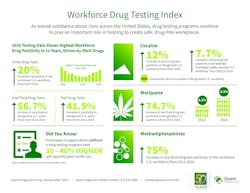Workforce Drug Use on the Rise [Infographic]
Workforce substance abuse is on the rise, driven by an increase an illicit drug use, according to a Quest Diagnostics report.
The report analyzed 10 million workforce urine test results. The company noted an increase across the board for cocaine, marijuana and methamphetamines.
"This year's findings are remarkable because they show increased rates of drug positivity for the most common illicit drugs across virtually all drug test specimen types and in all testing populations," said Dr. Barry Sample, senior director, science and technology, Quest Diagnostics. "Our analysis suggests that employers committed to creating a safe, drug-free work environment should be alert to the potential for drug use among their workforce."
In 2016, 4.2 percent of all urine tests came back positive, up from 4.0 percent in 2015 and the highest rate since 2004's 4.5 percent, according to the company.
Cocaine use continues to climb for the fourth consecutive year across the country. Usage was up 12 percent from 2015, reaching a seven-year high of 0.28 percent.
“Once again, the DTI (Drug Testing Index) statistics reveal the on-going threat to workplace safety posed by substance abuse. While the national dialogue swirls around marijuana and opiate issues, we find cocaine—a substance with well-established dangers—continuing its troubling upswing not just in the general workforce, but in safety-sensitive jobs with federally-mandated testing,” said Matt Nieman, General Counsel, Institute for a Drug-Free Workplace and Principal, Jackson Lewis P.C. “That positive test results for cocaine persist, let alone are increasing, should serve as a reminder to employers and employees that there is no substitute for vigilance in any effective effort to thwart the potential impacts of workplace substance abuse.”
According to Quest Diagnostics, the positivity rate for cocaine in post-accident urine drug tests was more than twice that of pre-employment drug tests, and also was higher than the rate in random drug tests.
Marijuana use is on the rise as well. Positive oral drug tests increased nearly 75 percent to 8.9 percent in 2016, up from 5.1 percent in 2013. Appearance in both urine and hair tests increased as well. These results largely are a result of the legalization of recreational drug use, according to researchers.
“We have been tracking the trends in marijuana positivity in states that have passed medical and recreational marijuana use statutes for several years now. 2016 is the first year since Colorado and Washington approved recreational use that the rates of year-over-year change were sharply higher than the national average,” said Dr. Sample.
Methamphetamine use has risen 64 percent between 2012 and 2016, according to Quest Diagnostics. This is after a four-year period in which positive tests plateaued, between 2008 and 2012.
For the first time in four years, positive urine tests results for heroin have declined along with usage for prescription drugs such as hydrocodone, hydromorphone and oxycodone, which have dropped four consecutive years in a row, driven by tighter laws regarding doctor-prescribed opiates.
The Quest Diagnostics Drug Testing Index (DTI), which is published annually since 1988, examines test results according to three categories of workers: federally-mandated, safety-sensitive workers, the general workforce and the combined U.S. workforce.

